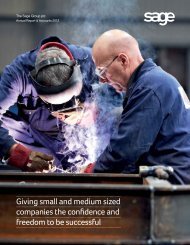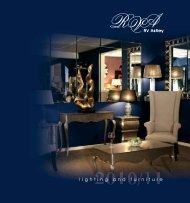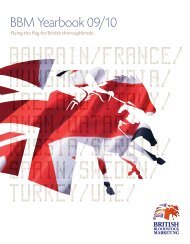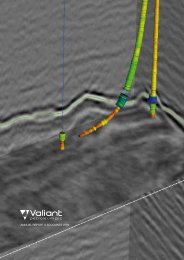You also want an ePaper? Increase the reach of your titles
YUMPU automatically turns print PDFs into web optimized ePapers that Google loves.
Flame Retardant Products<br />
Flame Retardant Products<br />
22<br />
national (class 1 & class 0) vs. european (euroclass) classifications<br />
The fire performance for all materials to be used in permanent constructions, including wood and wood based panel<br />
products, are stated in Approved Document Part B to the Building Regulations of England and Wales, currently<br />
allowing the use of fire classifications to either BS 476 British Standard fire tests or European Classification to BS EN<br />
13501-1, based on European fire tests. Similar changes in the legislation for Northern Ireland and Scotland also allow<br />
use of either classification.<br />
Where a particular product standard exists for a specific material (e.g. BS EN 13986 for wood based panels or BS EN<br />
14915 for solid wood panelling and cladding), compliance is mandatory if CE marking is required and only European<br />
fire tests can be used to provide fire classifications.<br />
British standards<br />
Class 1 and Class 0 have been the traditional fire<br />
performances required in the UK for a number of years.<br />
Class 1 (BS476 Part 7) is commonly referred to as the<br />
Surface Spread of Flame. Class 0 (BS476 Parts 6 & 7) is<br />
more stringent and includes Class 1 as above but also<br />
Part 6 which is known as the ‘Fire Propagation Index’<br />
which measures the heat released when timber burns.<br />
european classifications<br />
Whilst we are currently in a transitional stage between<br />
British Standards and the new European classifications,<br />
eventually, at some point in the next few years the<br />
European classifications will become mandatory for<br />
materials used for permanent constructions.<br />
To meet the new European classifications, the rate of<br />
fire growth, lateral flame spread, total heat release and<br />
smoke production for wood and wood based panel<br />
products derived from European tests are used to<br />
classify materials as Euroclass B or C in accordance with<br />
BS EN 13501-1. Important: a particular species /<br />
thickness is not deemed to have full formal Euroclass<br />
status (B or C) until a Classification report has been<br />
issued. Companies who fire treat timber / plywood<br />
should be able to present such certification on request<br />
as evidence of compliance.<br />
The thresholds to achieve Euroclass B are higher<br />
than those for Euroclass C and, therefore, if material<br />
conforms to Euroclass B then by definition it also<br />
conforms to Euroclass C.<br />
The UK transpositions for traditional classes to<br />
Euroclasses are:<br />
Class 1 Euroclass C<br />
Class 0 Euroclass B<br />
Whilst European classifications to BS EN 13501-1<br />
currently co-exist with traditional British Standards<br />
(BS476 Parts 6 and 7) within Building Regulations and<br />
either can be specified, these classifications are not<br />
equivalent because they are derived from different test<br />
methods measuring different properties.<br />
Therefore BS 476 Class 1 is not equivalent to Euroclass<br />
C and in turn Class 0 is not equal to Euroclass B.<br />
A product having a Euroclass B or Euroclass C<br />
classification cannot be sold as Class 0 or Class 1<br />
respectively<br />
Medite FR MDF Euroclass B is (currently) the only<br />
MDF that meets both Euroclass B and BS476 Class 0<br />
standards and can be used in both situations. Other<br />
manufacturers do not offer this so great care should be<br />
taken when deciding which product to use.<br />
A common question: Are the new Euroclasses as good<br />
as the old British Standards? The answer to this is that<br />
they are simply a new set of reaction to fire tests that<br />
are deemed as acceptable by Building Regulations as<br />
the old British Standards.<br />
Building Regulations dictate the fire performance<br />
required, depending upon the location of the fire treated<br />
material within the building.<br />
The fire performance commonly required for internal<br />
wall and ceiling linings is Class 1 Surface Spread of<br />
Flame in accordance with BS476: Part 7 or Euroclass C<br />
in accordance with BS EN 13501-1.<br />
The fire performance commonly required in higher risk<br />
areas such as external cladding within 1m of a boundary,<br />
escape routes and staircases is Class 0 BS 476: Parts 6<br />
& 7 or Euroclass B in accordance with BS EN 13501-1.<br />
Further processing<br />
Most timber products can be treated by pressure<br />
impregnation or surface coating processes to comply<br />
with FR regulations. Please contact us for the details of<br />
this service.<br />
Please note that where a fire test certificate is required<br />
for fabricated material, care must be taken to ensure<br />
that the total composite will achieve the required result,<br />
which can only be determined by appropriate testing.<br />
Customers and specifiers must satisfy themselves<br />
that the products they chose are fit for the required<br />
applications.

















